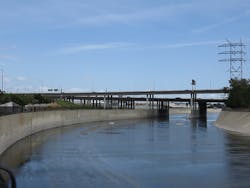U.S. Lubricants Inc. settles Clean Water Act violations with EPA
LOS ANGELES, JULY 23, 2019 – The U.S. Environmental Protection Agency (EPA) reached a settlement for civil penalties with U.S. Lubricants Inc. for Clean Water Act violations. Under the agreement, U.S. Lubricants will pay a $196,314 penalty. EPA recently entered into a separate agreement with the company to take steps to reduce the risk of oil spills from their petroleum storage facility in Commerce, California, to the Los Angeles River.
“It is essential that companies operating near our waterways develop and follow a spill prevention plan,” said EPA Pacific Southwest Regional Administrator Mike Stoker. “Our action will help prevent oil spills to the Los Angeles River.”
The facility is located near the Los Angeles River, which flows to Long Beach Harbor and the Pacific Ocean. An EPA inspection in May 2017 found that the company had violated the Clean Water Act's oil pollution prevention regulations by failing to:
- Inspect tanks and perform tank integrity testing.
- Provide adequate secondary containment around tanks to keep potential spills from leaving the site and entering waterways.
- Develop and implement a Facility Response Plan (FRP) to respond to major oil spills.
- Develop a Spill Prevention, Control and Countermeasure Plan (SPCC) certified by a professional engineer.
The requirement to develop an FRP Plan applies to facilities that store more than 1 million gallons of oil. The plan helps staff prevent and respond to an oil spill on-site. FRPs also help local and regional response authorities better understand potential hazards and response capabilities in their area.
EPA's oil pollution prevention regulations aim to prevent oil from reaching navigable waters and adjoining shorelines and to ensure containment of oil discharges in the event of a spill. Specific prevention measures include developing and implementing spill prevention plans, training staff, and installing physical controls to contain and clean up oil spills.
